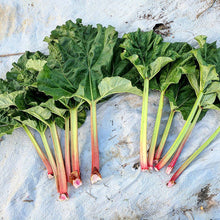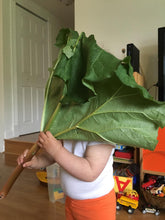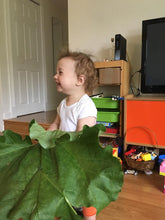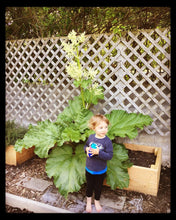'Tracy' Rhubarb
Regular price
$4.00
Sale
Rheum rhabarbarum
Origin: Greentown, Pennsylvania
Improvement status: Cultivar/Breeding material
Seeds per packet: ~30
Germination tested 11/2022: 74% (Below standard)
Life cycle: Perennial
EFN EXCLUSIVE. We love this rhubarb. If not for Nate, his late great mother Barbara Wolfson, and her old friend Barbara Tracy, plus a whole lot of luck, this wonderful rhubarb would likely have been lost forever. And if not for Nate's sister and brother-in-law in Ann Arbor, Michigan, we might not ever have seeds to offer (because it has never so much as flowered here in the Mid-Atlantic). Here's the full first-person account from Nate:
"For many years during my childhood, my family spent most of our summers up in the Pocono Mountains of Pennsylvania (with my mother, who was a radiologist at St. Christopher's Hospital for Children in North Philly, driving up to join us on weekends). I loved being a free-range kid there, able to explore the forests, fields and streams of that beautiful region. My folks chose the Poconos for one reason: that's where Barbara Tracy and her family spent their summers. Barbara was my Mom's best friend from college. During our years in the Poconos, which ended when I was 14, all of the Tracys — including Barbara's in-laws, the late Lazelle and Bill Tracy Sr. — treated us like a part of their extended family. We shot fireworks off at Elizabeth's horse farm, ice-skated on the lake behind Barbara and Billy's house, and picked blueberries from the enormous bushes behind Lazelle and Bill's.
Many years later, circa 2013, when my mother was slowly dying of cancer, she made a final trip to visit the Poconos and stay with her old friend Barbara. It was late summer, and my friend Eliot and I joined her and my Dad for the trip. I was still something of a vagabond at that point in my life — in my late 20s, living in a friend's barn — but EFN was already on the horizon, and I was already a profligate hoarder of plants. After showing me her own patch of ramps (begun decades earlier from plants she'd transplanted from North Carolina), Barbara mentioned to me that there was probably still some rhubarb growing at Lazelle and Bill's farmhouse. Her in-laws had both recently passed on, and their house was now up for sale. I asked if the blueberries were still there, which of course they were (in the acidic soil of the Poconos, blueberries need hardly any care), so we all hopped in a van and took a ride to Greentown. While I was marveling over the massive mayapples at the edge of the yard (which we now call 'Tracy' mayapples, and are still the largest I've ever seen) Barbara was pacing through one portion of grass looking for any signs of rhubarb. The lawn had long since taken over the old vegetable patch, and every couple weeks a lawnmower was driven over it, so when she finally found the rhubarb, it looked quite pathetic: little more than two pencil-thin stems each with a leaf not much bigger than a half-dollar coin. Nevertheless, we put shovel to soil and revealed a massive clump of roots. It was promptly placed in a garbage bag and we triumphantly returned to Barbara & Billy's for a delicious dinner.
Barbara believes that rhubarb was growing there for over fifty years, and it was likely started from seed. When I returned a few days later to my friend's farm in Yellow Springs, PA, I divided the clump into three sensible pieces, planted them in her garden, and spent the rest of the summer watching Lazelle and Bill's rhubarb spring back to life. The following year, upon arriving at the Deitrich farm in New Jersey, I was able to plant six clumps, and they soon became full-size, beautiful rhubarb plants. Divisions were soon dispatched to friends in Baltimore and Philadelphia, and to my sister Molly and her husband Piet in Ann Arbor, Michigan. It was their plant that bloomed last year [2017] and produced thousands of beautiful seeds. We've all grown to love and appreciate this plant so much, not only for its deeply personal story, but also for its wide, thick, well-flavored stalks, its hilariously huge leaves, and especially for its amazing resistance to Japanese Beetle infestation. Even when every other rhubarb at the farm is struggling in mid-summer, with beetles munching through every leaf, the 'Tracy' plants just keep on growing, practically untouched by the beetles. The strength and power of this singular clone is undeniable."
One note on growing rhubarb from seed: like most other typically clonally-propagated perennial vegetables (like asparagus, seakale, etc) rhubarb seeds will not grow "true to type," meaning the seedlings will turn up in an array of diverse forms. Ages ago, seed companies would explain the traits of the parent variety and urge customers to select for them as a way to "maintain" the variety, but in the end they really ended up creating more genetic diversity (which is why 'Victoria' rhubarb doesn't always look the same). As you can see in the side-by-side photo, with 'Tracy' on the left and a seedling of 'Glaskins Perpetual' on the right, this variety is typified by thick stalks and huge leaves. Seedings will take two or three years to get established, at which point the seedlings with the worst traits should be culled, while the best seedlings should be named and nurtured, on their way to becoming your own treasured heirlooms, divided and shared with the people you love for generations to come.
GROWING TIPS: Start plants in trays with potting mix. This could be in a greenhouse or outside after it warms up. Transplant to garden maybe a foot between plants.








